Leveraging Citizen Science and Low-Cost Sensors to Characterize Air Pollution Exposure of Disadvantaged Communities in Southern California
Abstract
1. Introduction
2. Materials and Methods
2.1. Study Area
2.2. Participant Recruitment
2.3. Monitoring Campaign
2.4. Quality Assurance and Quality Control (QA/QC)
2.5. Data Analysis
3. Results and Discussion
3.1. Spatial Patterns
3.2. Temporal Patterns
3.3. Temporal Patterns
3.4. Implications for Exposure Assessment across Disadvantaged Communities
3.5. Implications for Healthy Community Development across Disadvantaged Communities
3.6. Limitations and Implications for the Development of Future Research
4. Conclusions
Supplementary Materials
Author Contributions
Funding
Institutional Review Board Statement
Informed Consent Statement
Data Availability Statement
Acknowledgments
Conflicts of Interest
References
- World Health Organization (WHO). WHO Global Ambient Air Quality Database (Update 2018); WHO: Geneva, Switzerland, 2018.
- Cohen, A.J.; Brauer, M.; Burnett, R.; Anderson, H.R.; Frostad, J.; Estep, K.; Balakrishnan, K.; Brunekreef, B.; Dandona, L.; Dandona, R.; et al. Estimates and 25-Year Trends of the Global Burden of Disease Attributable to Ambient Air Pollution: An Analysis of Data from the Global Burden of Diseases Study 2015. Lancet 2017, 389, 1907–1918. [Google Scholar] [CrossRef]
- Li, Z.; Liu, Y.; Lu, T.; Peng, S.; Liu, F.; Sun, J. Ecotoxicology and Environmental Safety Acute Effect of Fine Particulate Matter on Blood Pressure, Heart Rate and Related Inflammation Biomarkers: A Panel Study in Healthy Adults. Ecotoxicol. Environ. Saf. 2021, 228, 113024. [Google Scholar] [CrossRef] [PubMed]
- Rickenbacker, H.; Brown, F.; Bilec, M. Creating Environmental Consciousness in Underserved Communities: Implementation and Outcomes of Community-Based Environmental Justice and Air Pollution Research. Sustain. Cities Soc. 2019, 47, 101473. [Google Scholar] [CrossRef]
- Rosofsky, A.; Levy, J.I.; Zanobetti, A.; Janulewicz, P.; Fabian, M.P. Temporal Trends in Air Pollution Exposure Inequality in Massachusetts. Environ. Res. 2018, 161, 76–86. [Google Scholar] [CrossRef]
- Morello-Frosch, R.; Pastor, M.; Porras, C.; Sadd, J. Environmental Justice and Regional Inequality in Southern California: Implications for Future Research. Community Res. Environ. Health Stud. Sci. Advocacy Ethics 2017, 110, 205–218. [Google Scholar] [CrossRef]
- Liu, J.; Clark, L.P.; Bechle, M.J.; Hajat, A.; Kim, S.Y.; Robinson, A.L.; Sheppard, L.; Szpiro, A.A.; Marshall, J.D. Disparities in Air Pollution Exposure in the United States by Race/Ethnicity and Income, 1990–2010. Environ. Health Perspect. 2021, 129, 127005. [Google Scholar] [CrossRef]
- Tessum, C.W.; Paolella, D.A.; Chambliss, S.E.; Apte, J.S.; Hill, J.D.; Marshall, J.D. PM2.5 Polluters Disproportionately and Systemically Affect People of Color in the United States. Sci. Adv. 2021, 7, eabf4491. [Google Scholar] [CrossRef]
- Jorgenson, A.K.; Hill, T.D.; Clark, B.; Thombs, R.P.; Ore, P.; Balistreri, K.S.; Givens, J.E. Power, Proximity, and Physiology: Does Income Inequality and Racial Composition Amplify the Impacts of Air Pollution on Life Expectancy in the United States? Environ. Res. Lett. 2020, 15, 024013. [Google Scholar] [CrossRef]
- deSouza, P.; Kinney, P.L. On the Distribution of Low-Cost PM2.5 Sensors in the US: Demographic and Air Quality Associations. J. Expo. Sci. Environ. Epidemiol. 2021, 31, 514–524. [Google Scholar] [CrossRef]
- Sullivan, D.M.; Krupnick, A. Using Satellite Data to Fill the Gaps in the US Air Pollution Monitoring Network. Resour. Future Work. Pap. 2018, 18. Available online: https://www.rff.org/publications/working-papers/using-satellite-data-to-fill-the-gaps-in-the-us-air-pollution-monitoring-network/ (accessed on 29 August 2021).
- Feinberg, S.N.; Williams, R.; Hagler, G.; Low, J.; Smith, L.; Brown, R.; Garver, D.; Davis, M.; Morton, M.; Schaefer, J.; et al. Examining Spatiotemporal Variability of Urban Particulate Matter and Application of High-Time Resolution Data from a Network of Low-Cost Air Pollution Sensors. Atmos. Environ. 2019, 213, 579–584. [Google Scholar] [CrossRef]
- Bi, J.; Stowell, J.; Seto, E.Y.W.; English, P.B.; Al-Hamdan, M.Z.; Kinney, P.L.; Freedman, F.R.; Liu, Y. Contribution of Low-Cost Sensor Measurements to the Prediction of PM2.5 Levels: A Case Study in Imperial County, California, USA. Environ. Res. 2020, 180, 108810. [Google Scholar] [CrossRef] [PubMed]
- Woo, B.; Kravitz-Wirtz, N.; Sass, V.; Crowder, K.; Teixeira, S.; Takeuchi, D.T. Residential Segregation and Racial/Ethnic Disparities in Ambient Air Pollution. Race Soc. Probl. 2019, 11, 60–67. [Google Scholar] [CrossRef] [PubMed]
- Xu, Y.; Jiang, S.; Li, R.; Zhang, J.; Zhao, J.; Abbar, S.; González, M.C. Unraveling Environmental Justice in Ambient PM 2.5 Exposure in Beijing: A Big Data Approach. Comput. Environ. Urban Syst. 2019, 75, 12–21. [Google Scholar] [CrossRef]
- Hall, E.S.; Kaushik, S.M.; Vanderpool, R.W.; Duvall, R.M.; Beaver, M.R.; Long, R.W.; Solomon, P.A. Federal Reference Method (FRM), Federal Equivalent Method (FEM), National Ambient Air Quality Standards (NAAQS), Sensors; Federal Reference Method (FRM), Federal Equivalent Method (FEM), National Ambient Air Quality Standards (NAAQS), Sensors. Am. J. Environ. Eng. 2014, 4, 147–154. [Google Scholar] [CrossRef]
- Jiao, W.; Hagler, G.; Williams, R.; Sharpe, R.; Brown, R.; Garver, D.; Judge, R.; Caudill, M.; Rickard, J.; Davis, M.; et al. Community Air Sensor Network (CAIRSENSE) Project: Evaluation of Low-Cost Sensor Performance in a Suburban Environment in the Southeastern United States. Atmos. Meas. Tech. 2016, 9, 5281–5292. [Google Scholar] [CrossRef]
- English, P.B.; Richardson, M.J.; Garzón-Galvis, C. From Crowdsourcing to Extreme Citizen Science: Participatory Research for Environmental Health. Annu. Rev. Public Health 2018, 39, 335–350. [Google Scholar] [CrossRef] [PubMed]
- Lu, T.; Lansing, J.; Zhang, W.; Bechle, M.J.; Hankey, S. Land Use Regression Models for 60 Volatile Organic Compounds: Comparing Google Point of Interest (POI) and City Permit Data. Sci. Total Environ. 2019, 677, 131–141. [Google Scholar] [CrossRef] [PubMed]
- Perelló, J.; Cigarini, A.; Vicens, J.; Bonhoure, I.; Rojas-Rueda, D.; Nieuwenhuijsen, M.J.; Cirach, M.; Daher, C.; Targa, J.; Ripoll, A. Large-Scale Citizen Science Provides High-Resolution Nitrogen Dioxide Values and Health Impact While Enhancing Community Knowledge and Collective Action. Sci. Total Environ. 2021, 789, 147750. [Google Scholar] [CrossRef]
- Varaden, D.; Leidland, E.; Lim, S.; Barratt, B. “I Am an Air Quality Scientist”–Using Citizen Science to Characterise School Children’s Exposure to Air Pollution. Environ. Res. 2021, 201, 111536. [Google Scholar] [CrossRef] [PubMed]
- Bi, J.; Wildani, A.; Chang, H.H.; Liu, Y. Incorporating Low-Cost Sensor Measurements into High-Resolution PM2.5 Modeling at a Large Spatial Scale. Environ. Sci. Technol. 2020, 54, 2152–2162. [Google Scholar] [CrossRef] [PubMed]
- Lu, Y.; Giuliano, G.; Habre, R. Estimating Hourly PM2.5 Concentrations at the Neighborhood Scale Using a Low-Cost Air Sensor Network: A Los Angeles Case Study. Environ. Res. 2021, 195, 110653. [Google Scholar] [CrossRef] [PubMed]
- Lu, T.; Bechle, M.J.; Wan, Y.; Presto, A.A.; Hankey, S. Using Crowd-Sourced Low-Cost Sensors in a Land Use Regression of PM2.5 in 6 US Cities. Air Qual. Atmos. Health 2022, 15, 667–678. [Google Scholar] [CrossRef]
- Mahajan, S.; Kumar, P.; Pinto, J.A.; Riccetti, A.; Schaaf, K.; Camprodon, G.; Smári, V.; Passani, A.; Forino, G. A Citizen Science Approach for Enhancing Public Understanding of Air Pollution. Sustain. Cities Soc. 2020, 52, 101800. [Google Scholar] [CrossRef]
- Austen, K. Pollution Patrol. Nature 2015, 517, 136–138. [Google Scholar] [CrossRef]
- Barkjohn, K.K.; Gantt, B.; Clements, A.L. Development and Application of a United States-Wide Correction for PM 2.5 Data Collected with the PurpleAir Sensor. Atmos. Meas. Tech. 2021, 14, 4617–4637. [Google Scholar] [CrossRef]
- Hasheminassab, S.; Daher, N.; Saffari, A.; Wang, D.; Ostro, B.D.; Sioutas, C. Spatial and Temporal Variability of Sources of Ambient Fine Particulate Matter (PM2.5) in California. Atmos. Chem. Phys. 2014, 5, 12085–12097. [Google Scholar] [CrossRef]
- Lurmann, F.; Avol, E.; Gilliland, F.; Lurmann, F.; Avol, E.; Gilliland, F. Emissions Reduction Policies and Recent Trends in Southern California’s Ambient Air Quality Emissions Reduction Policies and Recent Trends in Southern California ’ s Ambient Air Quality. J. Air Waste Manag. Assoc. 2015, 65, 324–335. [Google Scholar] [CrossRef]
- Johnston, J.E.; Juarez, Z.; Navarro, S.; Hernandez, A.; Gutschow, W. Youth Engaged Participatory Air Monitoring: A ‘Day in the Life’ in Urban Environmental Justice Communities. Int. J. Environ. Res. Public Health 2020, 17, 93. [Google Scholar] [CrossRef]
- Mullen, C.; Flores, A.; Grineski, S.; Collins, T. Exploring the Distributional Environmental Justice Implications of an Air Quality Monitoring Network in Los Angeles County. Environ. Res. 2022, 206, 112612. [Google Scholar] [CrossRef]
- The Office of Environmental Health Hazard Assessment (OEHHA) CalEnviroScreen 4.0. Available online: https://oehha.ca.gov/calenviroscreen/report/calenviroscreen-40 (accessed on 28 August 2021).
- US Environmental Protection Agency (US EPA) California Nonattainment/Maintenance Status for Each County by Year for All Criteria Pollutants. Available online: https://www3.epa.gov/airquality/greenbook/anayo_ca.html (accessed on 29 August 2021).
- Brauer, M.; Lee, M. Evaluation of Portable Air Quality Sensors at the Vancouver (Clark Drive) near-Road Air Quality Monitoring Site. 2018. Available online: https://open.library.ubc.ca/soa/cIRcle/collections/facultyresearchandpublications/52383/items/1.0380965 (accessed on 29 March 2021).
- South Coast Air Quality Management District Field Evaluation Purple Air PM Sensor Background. Available online: http://www.aqmd.gov/docs/default-source/aq-spec/field-evaluations/purple-air-pa-ii---field-evaluation.pdf?sfvrsn=2 (accessed on 23 May 2020).
- Malings, C.; Tanzer, R.; Hauryliuk, A.; Saha, P.K.; Allen, L.; Presto, A.A.; Subramanian, R.; Malings, C.; Tanzer, R.; Hauryliuk, A.; et al. Fine Particle Mass Monitoring with Low-Cost Sensors: Corrections and Long-Term Performance Evaluation Term Performance Evaluation. Aerosol Sci. Technol. 2020, 54, 160–174. [Google Scholar] [CrossRef]
- Xu, R. Particuology Light Scattering: A Review of Particle Characterization Applications. Particuology 2015, 18, 11–21. [Google Scholar] [CrossRef]
- Bishop, G.A. Three Decades of On-Road Mobile Source Emissions Reductions in South Los Angeles. J. Air Waste Manag. Assoc. 2019, 69, 967–976. [Google Scholar] [CrossRef]
- Mousavi, A.; Sowlat, M.H.; Hasheminassab, S.; Pikelnaya, O.; Polidori, A.; Ban-weiss, G.; Sioutas, C. Impact of Particulate Matter (PM) Emissions from Ships, Locomotives, and Freeways in the Communities near the Ports of Los Angeles (POLA) and Long Beach (POLB) on the Air Quality in the Los Angeles County. Atmos. Environ. 2018, 195, 159–169. [Google Scholar] [CrossRef]
- Hu, S.; Polidori, A.; Arhami, M.; Shafer, M.M.; Schauer, J.J.; Cho, A.; Sioutas, C. And Physics Redox Activity and Chemical Speciation of Size Fractioned PM in the Communities of the Los Angeles-Long Beach Harbor. Atmos. Che 2008, 8, 6439–6451. [Google Scholar] [CrossRef]
- Lee, H.J.; Park, H. Prioritizing the Control of Emission Sources to Mitigate PM2.5 Disparity in California. Atmos. Environ. 2020, 224, 117316. [Google Scholar] [CrossRef]
- Di, Q.; Kloog, I.; Koutrakis, P.; Lyapustin, A.; Wang, Y.; Schwartz, J. Assessing PM 2.5 Exposures with High Spatiotemporal Resolution across the Continental United States. Environ. Sci. Technol. 2016, 50, 4712–4721. [Google Scholar] [CrossRef]
- Lee, C. Impacts of Multi-Scale Urban Form on PM2.5 Concentrations Using Continuous Surface Estimates with High-Resolution in U. S. Metropolitan Areas. Landsc. Urban Plan. 2020, 204, 103935. [Google Scholar] [CrossRef]
- Cooper, N.; Green, D.; Knibbs, L.D. Inequalities in Exposure to the Air Pollutants PM2.5 and NO2 in Australia. Environ. Res. Lett. 2019, 14, 115005. [Google Scholar] [CrossRef]
- Hajat, A.; Hsia, C.; O’Neill, M.S. Socioeconomic Disparities and Air Pollution Exposure: A Global Review. Curr. Environ. Health Rep. 2015, 2, 440–450. [Google Scholar] [CrossRef]
- Mikati, I.; Benson, A.F.; Luben, T.J.; Sacks, J.D.; Richmond-Bryant, J. Disparities in Distribution of Particulate Matter Emission Sources by Race and Poverty Status. Am. J. Public Health 2018, 108, 480–485. [Google Scholar] [CrossRef] [PubMed]
- Racz, L.A.; Rish, W. Exposure Monitoring toward Environmental Justice. Integr. Environ. Assess. Manag. 2021, 18, 858–862. [Google Scholar] [CrossRef] [PubMed]
- Masri, S.; Cox, K.; Flores, L.; Rea, J.; Wu, J. Community-Engaged Use of Low-Cost Sensors to Assess the Spatial Distribution of PM2.5 Concentrations across Disadvantaged Communities: Results from a Pilot Study in Santa Ana, CA. Atmosphere 2022, 13, 304. [Google Scholar] [CrossRef]
- Chan, E.A.W.; Gantt, B.; McDow, S. The Reduction of Summer Sulfate and Switch from Summertime to Wintertime PM2.5 Concentration Maxima in the United States. Atmos. Environ. 2018, 175, 25–32. [Google Scholar] [CrossRef]
- Zhao, N.; Liu, Y.; Vanos, J.K.; Cao, G. Day-of-Week and Seasonal Patterns of PM2.5 Concentrations over the United States: Time-Series Analyses Using the Prophet Procedure. Atmos. Environ. 2018, 192, 116–127. [Google Scholar] [CrossRef]
- Lewis, J.; De Young, R.; Ferrare, R.; Allen Chu, D. Comparison of Summer and Winter California Central Valley Aerosol Distributions from Lidar and MODIS Measurements. Atmos. Environ. 2010, 44, 4510–4520. [Google Scholar] [CrossRef][Green Version]
- Chen, T.; He, J.; Lu, X.; She, J.; Guan, Z. Spatial and Temporal Variations of PM2.5 and Its Relation to Meteorological Factors in the Urban Area of Nanjing, China. Int. J. Environ. Res. Public Health 2016, 13, 921. [Google Scholar] [CrossRef]
- Connolly, R.E.; Yu, Q.; Wang, Z.; Chen, Y.; Liu, J.Z.; Collier-oxandale, A.; Papapostolou, V.; Polidori, A.; Zhu, Y. Long-Term Evaluation of a Low-Cost Air Sensor Network for Monitoring Indoor and Outdoor Air Quality at the Community Scale. Sci. Total Environ. 2022, 807, 150797. [Google Scholar] [CrossRef]
- Motallebi, N.; Tran, H.; Croes, B.E.; Larsen, L.C. Day-of-Week Patterns of Particulate Matter and Its Chemical Components at Selected Sites in California? J. Air Waste Manag. Assoc. 2003, 53, 876–888. [Google Scholar] [CrossRef]
- Lough, G.C.; Schauer, J.J.; Lawson, D.R. Day-of-Week Trends in Carbonaceous Aerosol Composition in the Urban Atmosphere. Atmos. Environ. 2006, 40, 4137–4149. [Google Scholar] [CrossRef]
- Yuan, Q. Environmental Justice in Warehousing Location: State of the Art. J. Plan. Lit. 2018, 33, 287–298. [Google Scholar] [CrossRef]
- Giuliano, G.; Brien, T.O. Reducing Port-Related Truck Emissions: The Terminal Gate Appointment System at the Ports of Los Angeles and Long Beach. Transp. Res. Part D Transp. 2007, 12, 460–473. [Google Scholar] [CrossRef]
- Wang, M.; Beelen, R.; Basagana, X.; Becker, T.; Cesaroni, G.; De Hoogh, K.; Dedele, A.; Declercq, C.; Dimakopoulou, K.; Eeftens, M.; et al. Evaluation of Land Use Regression Models for NO2 and Particulate Matter in 20 European Study Areas: The ESCAPE Project. Environ. Sci. Technol. 2013, 47, 4357–4364. [Google Scholar] [CrossRef] [PubMed]
- Eeftens, M.; Tsai, M.Y.; Ampe, C.; Anwander, B.; Beelen, R.; Bellander, T.; Cesaroni, G.; Cirach, M.; Cyrys, J.; de Hoogh, K.; et al. Spatial Variation of PM2.5, PM10, PM2.5 Absorbance and PMcoarse Concentrations between and within 20 European Study Areas and the Relationship with NO2—Results of the ESCAPE Project. Atmos. Environ. 2012, 62, 303–317. [Google Scholar] [CrossRef]
- Vallius, M.; Janssen, N.A.H.; Heinrich, J.; Hoek, G.; Ruuskanen, J.; Cyrys, J.; Van Grieken, R.; De Hartog, J.J.; Kreyling, W.G.; Pekkanen, J. Sources and Elemental Composition of Ambient PM2.5 in Three European Cities. Sci. Total Environ. 2005, 337, 147–162. [Google Scholar] [CrossRef]
- Auchincloss, A.H.; Diez Roux, A.V.; Dvonch, J.T.; Brown, P.L.; Barr, R.G.; Daviglus, M.L.; Goff, D.C.; Kaufman, J.D.; O’Neill, M.S. Associations between Recent Exposure to Ambient Fine Particulate Matter and Blood Pressure in the Multi-Ethnic Study of Atherosclerosis (MESA). Environ. Health Perspect. 2008, 116, 486–491. [Google Scholar] [CrossRef]
- Zhu, Y.; Hinds, W.C.; Kim, S.; Shen, S. Study of Ultrafine Particles near a Major Highway with Heavy-Duty Diesel Traffic. Atmos. Environ. 2002, 36, 4323–4335. [Google Scholar] [CrossRef]
- Karner, A.A.; Eisinger, D.S.; Niemeier, D.E.B.A. Near-Roadway Air Quality: Synthesizing the Findings from Real-World Data. Environ. Sci. Technol. 2010, 44, 5334–5344. [Google Scholar] [CrossRef]
- Pant, P.; Harrison, R.M. Estimation of the Contribution of Road Traf Fi c Emissions to Particulate Matter Concentrations from Fi Eld Measurements: A Review. Atmos. Environ. 2013, 77, 78–97. [Google Scholar] [CrossRef]
- Zhou, S.; Lin, R. Spatial-Temporal Heterogeneity of Air Pollution: The Relationship between Built Environment and on-Road PM2.5 at Micro Scale. Transp. Res. Part D 2019, 76, 305–322. [Google Scholar] [CrossRef]
- Hankey, S.; Marshall, J.D. Land Use Regression Models of On-Road Particulate Air Pollution (Particle Number, Black Carbon, PM2.5, Particle Size) Using Mobile Monitoring. Environ. Sci. Technol. 2015, 49, 9194–9202. [Google Scholar] [CrossRef]
- Farrell, W.; Weichenthal, S.; Goldberg, M.; Valois, M.; Shekarrizfard, M.; Hatzopoulou, M. Near Roadway Air Pollution across a Spatially Extensive Road and Cycling Network. Environ. Pollut. 2016, 212, 498–507. [Google Scholar] [CrossRef] [PubMed]
- Kashem, S.B.; Irawan, A.; Wilson, B. Evaluating the Dynamic Impacts of Urban Form on Transportation and Environmental Outcomes in US Cities. Int. J. Environ. Sci. Technol. 2014, 11, 2233–2244. [Google Scholar] [CrossRef]
- Larkin, A.; Van Donkelaar, A.; Geddes, A.; Martin, R.V.; Hystad, P. Quality in East Asia from 2000 to 2010. Environ. Sci. Technol. 2016, 50, 9142–9149. [Google Scholar] [CrossRef] [PubMed]
- Mccarty, J.; Kaza, N. Urban Form and Air Quality in the United States. Landsc. Urban Plan. 2015, 139, 168–179. [Google Scholar] [CrossRef]
- James, P.; Hart, J.E.; Laden, F. Neighborhood Walkability and Particulate Air Pollution in a Nationwide Cohort of Women. Environ. Res. 2015, 142, 703–711. [Google Scholar] [CrossRef]
- Chakraborty, J.; Zandbergen, P.A. Children at Risk: Measuring Racial/Ethnic Disparities in Potential Exposure to Air Pollution at School and Home. J. Epidemiol. Community Health 2007, 61, 1074–1079. [Google Scholar] [CrossRef]
- Hankey, S.; Marshall, J.D. Urban Form, Air Pollution, and Health. Curr. Environ. Health Rep. 2017, 4, 491–503. [Google Scholar] [CrossRef]
- Lu, T.; Marshall, J.D.; Zhang, W.; Hystad, P.; Kim, S.; Bechle, M.J.; Demuzere, M.; Hankey, S. National Empirical Models of Air Pollution Using Microscale Measures of the Urban Environment. Environ. Sci. Technol. 2021, 55, 15519–15530. [Google Scholar] [CrossRef]
- Gardner-Frolick, R.; Boyd, D.; Giang, A. Selecting Data Analytic and Modeling Methods to Support Air Pollution and Environmental Justice Investigations: A Critical Review and Guidance Framework. Environ. Sci. Technol. 2022, 56, 2843–2860. [Google Scholar] [CrossRef]
- Hutch, D.J.; Bouye, K.E.; Skillen, E.; Lee, C.; Whitehead, L.; Rashid, J.R. Collaborative Strategies to Improve Public Health Potential Strategies to Eliminate Built Environment Disparities for Disadvantaged and Vulnerable Communities. Gov. Politics Law 2011, 101, 587–595. [Google Scholar] [CrossRef]
- Hankey, S.; Lindsey, G.; Marshall, J.D. Population-Level Exposure to Particulate Air Pollution during Active Travel: Planning for Low-Exposure, Health-Promoting Cities. Environ. Health Perspect. 2017, 125, 527–534. [Google Scholar] [CrossRef]
- Hankey, S.; Sforza, P.; Pierson, M. Using Mobile Monitoring to Develop Hourly Empirical Models of Particulate Air Pollution in a Rural Appalachian Community. Environ. Sci. Technol. 2019, 53, 4305–4315. [Google Scholar] [CrossRef]
- Messier, K.P.; Chambliss, S.E.; Gani, S.; Alvarez, R.; Brauer, M.; Choi, J.J.; Hamburg, S.P.; Kerckho, J.; Lafranchi, B.; Lunden, M.M.; et al. Mapping Air Pollution with Google Street View Cars: E Ffi Cient Approaches with Mobile Monitoring and Land Use Regression. Environ. Sci. Technol. 2018, 52, 12563–12572. [Google Scholar] [CrossRef] [PubMed]
- Liang, Y.; Sengupta, D.; Campmier, M.J.; Lunderberg, D.M.; Apte, J.S. Wildfire Smoke Impacts on Indoor Air Quality Assessed Using Crowdsourced Data in California. Proc. Natl. Acad. Sci. USA 2021, 118, e2106478118. [Google Scholar] [CrossRef]
- Adamkiewicz, G.; Zota, A.R.; Fabian, M.P.; Chahine, T.; Julien, R.; Spengler, J.D. Moving Environmental Justice Indoors: Understanding Structural Influences on Residential Exposure Patterns in Low-Income Communities. Am. J. Public Health 2011, 101, 238–245. [Google Scholar] [CrossRef]
- Habre, R.; Girguis, M.; Urman, R.; Fruin, S.; Lurmann, F.; Shafer, M.; Gorski, P.; Franklin, M.; Mcconnell, R.; Avol, E.; et al. Contribution of Tailpipe and Non-Tailpipe Traffic Sources to Quasi-Ultrafine, Fine and Coarse Particulate Matter in Southern California. J. Air Waste Manag. Assoc. 2021, 71, 209–230. [Google Scholar] [CrossRef]
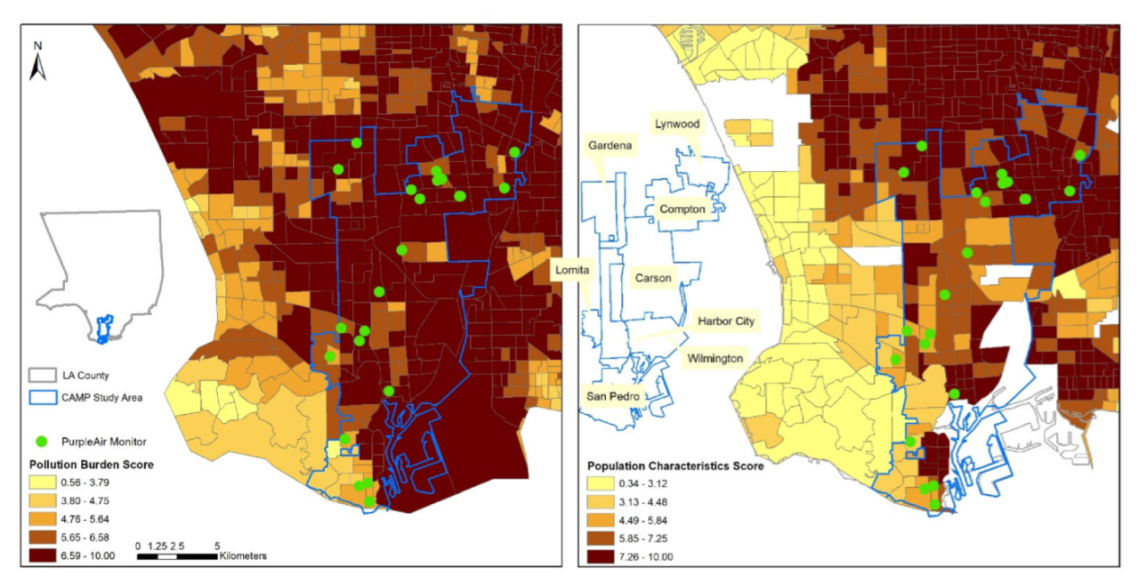
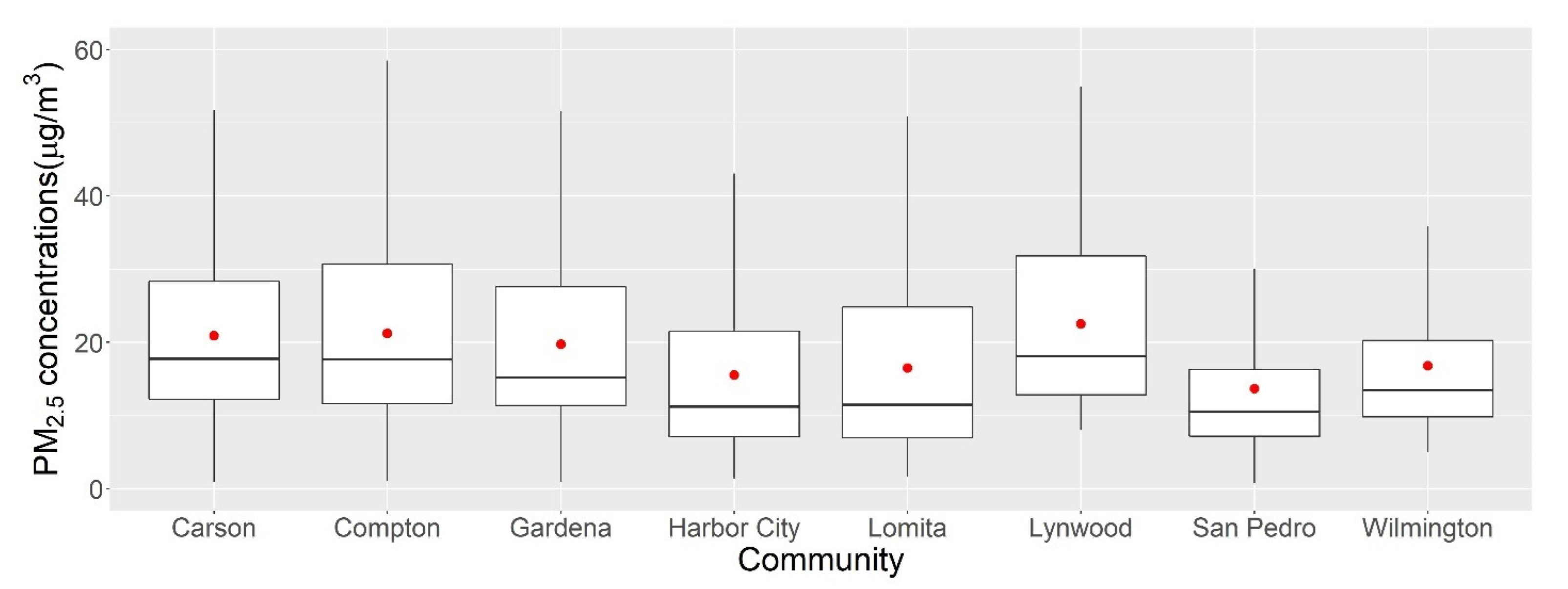
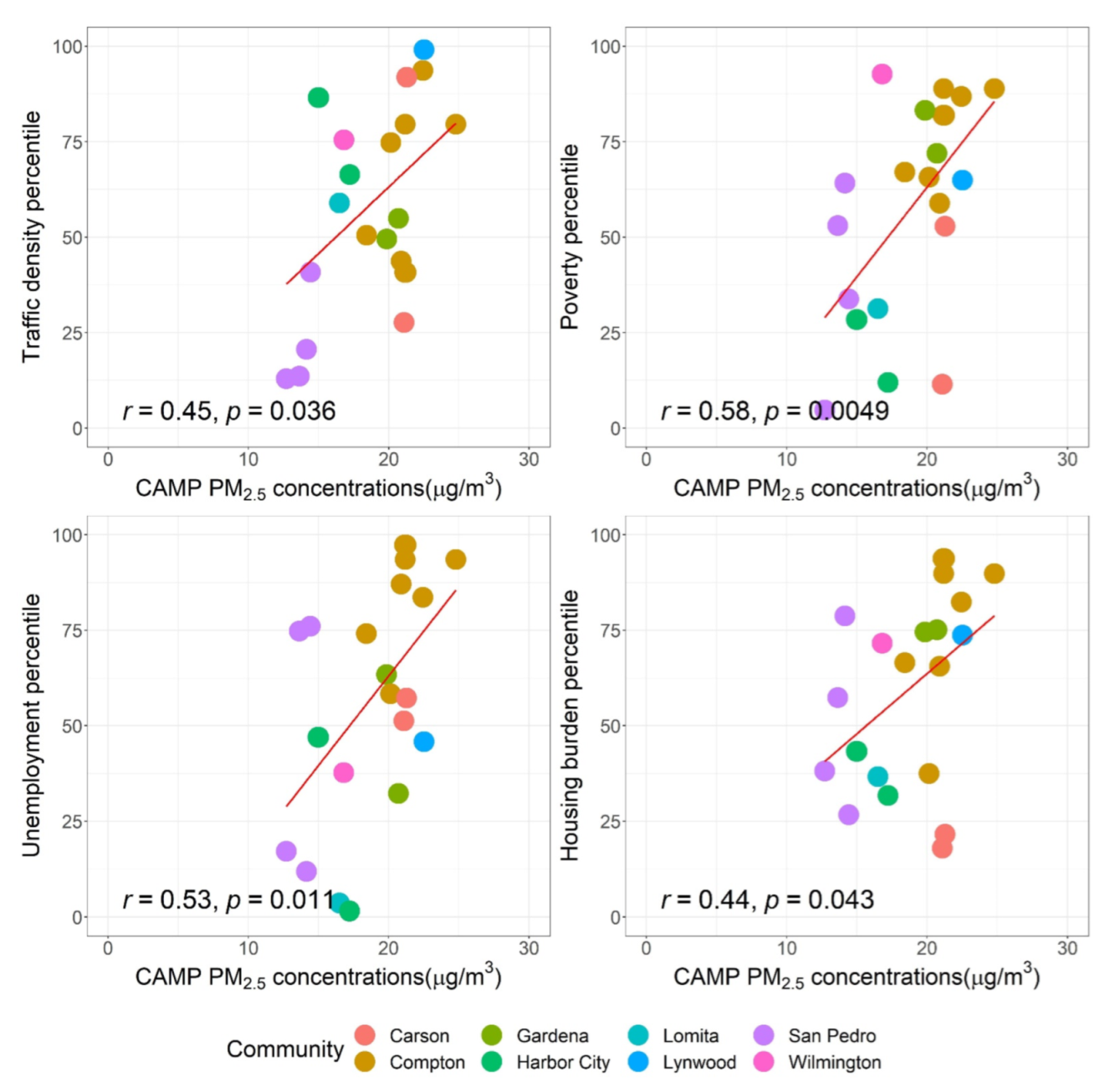
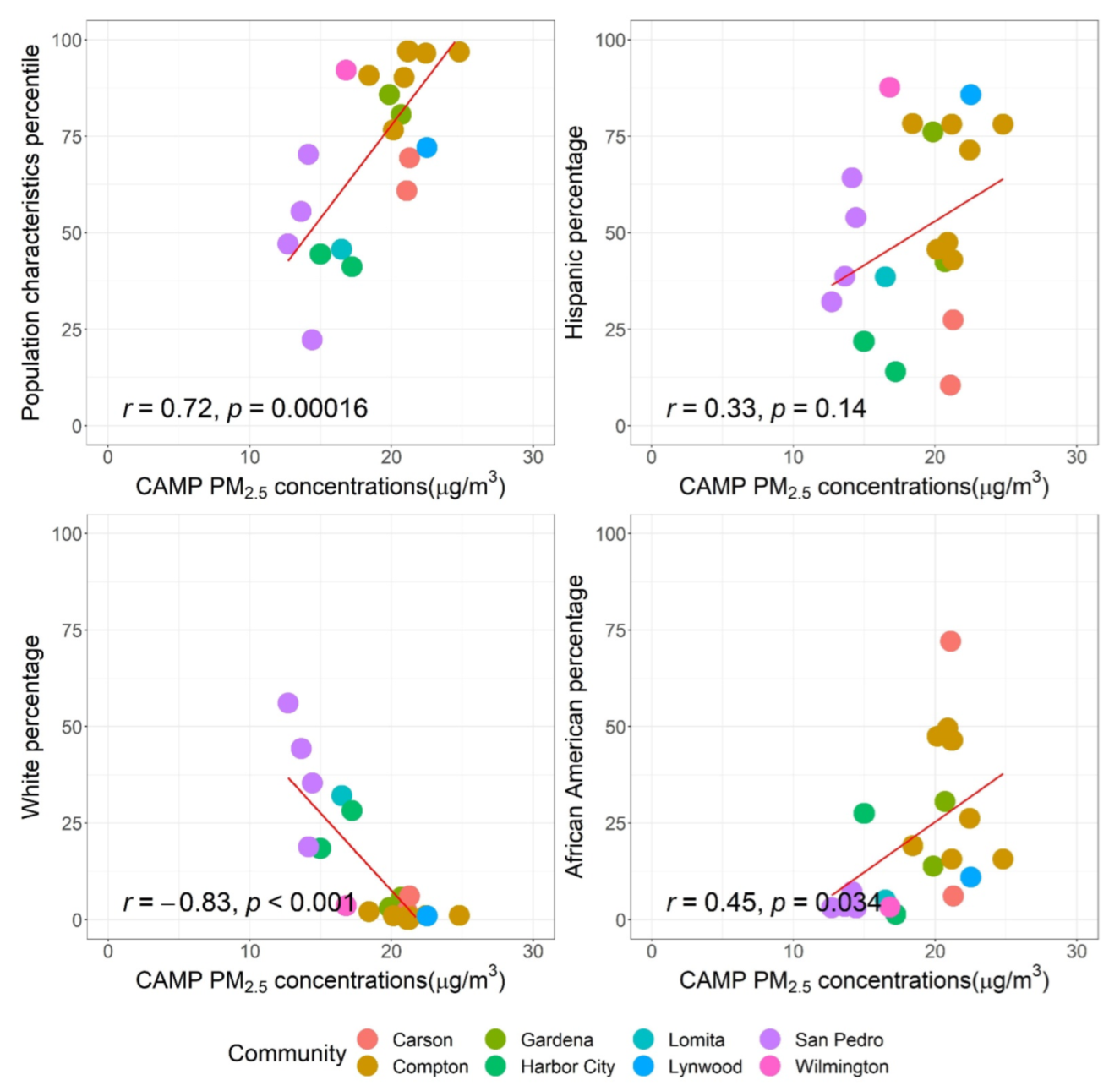
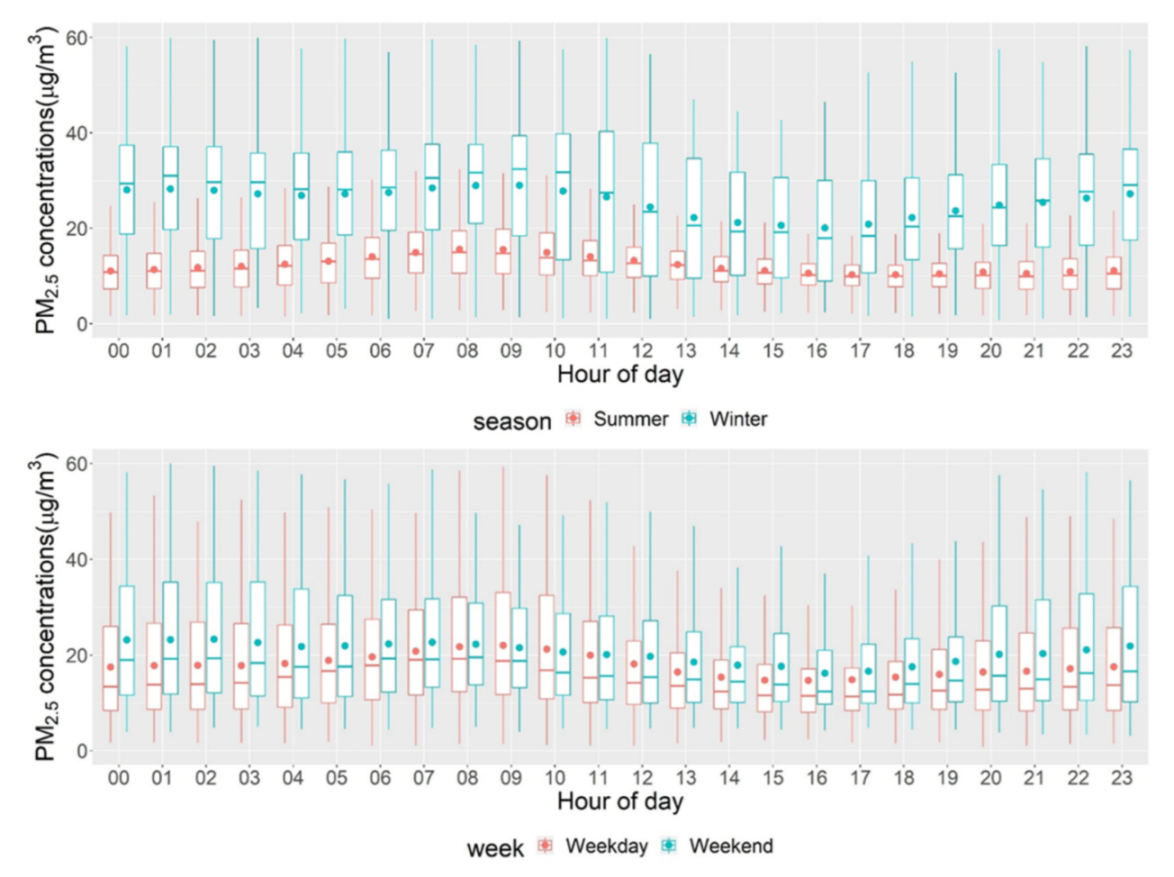
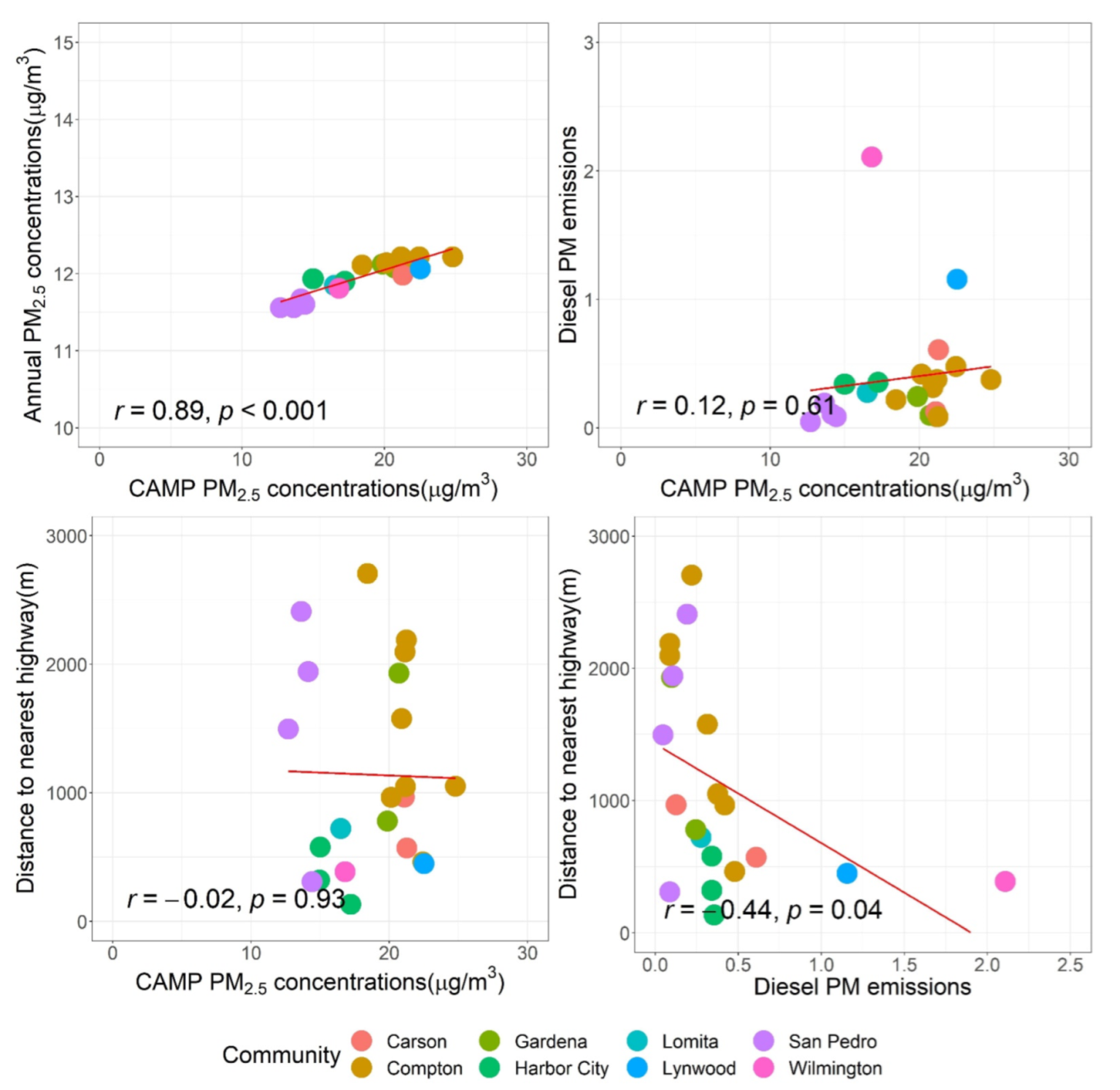

Publisher’s Note: MDPI stays neutral with regard to jurisdictional claims in published maps and institutional affiliations. |
© 2022 by the authors. Licensee MDPI, Basel, Switzerland. This article is an open access article distributed under the terms and conditions of the Creative Commons Attribution (CC BY) license (https://creativecommons.org/licenses/by/4.0/).
Share and Cite
Lu, T.; Liu, Y.; Garcia, A.; Wang, M.; Li, Y.; Bravo-villasenor, G.; Campos, K.; Xu, J.; Han, B. Leveraging Citizen Science and Low-Cost Sensors to Characterize Air Pollution Exposure of Disadvantaged Communities in Southern California. Int. J. Environ. Res. Public Health 2022, 19, 8777. https://doi.org/10.3390/ijerph19148777
Lu T, Liu Y, Garcia A, Wang M, Li Y, Bravo-villasenor G, Campos K, Xu J, Han B. Leveraging Citizen Science and Low-Cost Sensors to Characterize Air Pollution Exposure of Disadvantaged Communities in Southern California. International Journal of Environmental Research and Public Health. 2022; 19(14):8777. https://doi.org/10.3390/ijerph19148777
Chicago/Turabian StyleLu, Tianjun, Yisi Liu, Armando Garcia, Meng Wang, Yang Li, German Bravo-villasenor, Kimberly Campos, Jia Xu, and Bin Han. 2022. "Leveraging Citizen Science and Low-Cost Sensors to Characterize Air Pollution Exposure of Disadvantaged Communities in Southern California" International Journal of Environmental Research and Public Health 19, no. 14: 8777. https://doi.org/10.3390/ijerph19148777
APA StyleLu, T., Liu, Y., Garcia, A., Wang, M., Li, Y., Bravo-villasenor, G., Campos, K., Xu, J., & Han, B. (2022). Leveraging Citizen Science and Low-Cost Sensors to Characterize Air Pollution Exposure of Disadvantaged Communities in Southern California. International Journal of Environmental Research and Public Health, 19(14), 8777. https://doi.org/10.3390/ijerph19148777









